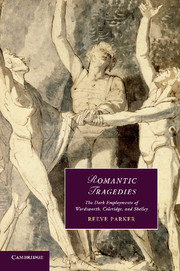Book contents
- Frontmatter
- Contents
- List of illustrations
- Acknowledgments
- Introduction: “Prowling out for dark employments”
- PART I WORDSWORTH
- PART II COLERIDGE AND SHELLEY
- CHAPTER 5 Osorio's dark employments: tricking out Coleridgean tragedy
- CHAPTER 6 Listening to Remorse: assuming man's infirmities
- CHAPTER 7 Reading Shelley's delicacy
- Notes
- Bibliography
- Index
- CAMBRIDGE STUDIES IN ROMANTICISM
CHAPTER 7 - Reading Shelley's delicacy
Published online by Cambridge University Press: 05 May 2014
- Frontmatter
- Contents
- List of illustrations
- Acknowledgments
- Introduction: “Prowling out for dark employments”
- PART I WORDSWORTH
- PART II COLERIDGE AND SHELLEY
- CHAPTER 5 Osorio's dark employments: tricking out Coleridgean tragedy
- CHAPTER 6 Listening to Remorse: assuming man's infirmities
- CHAPTER 7 Reading Shelley's delicacy
- Notes
- Bibliography
- Index
- CAMBRIDGE STUDIES IN ROMANTICISM
Summary
We visited the Colonna and Doria palaces, where the portraits of Beatrice were to be found, and her beauty cast the reflection of its own grace over her appalling story. Shelley's imagination became strongly excited, and he urged the subject to me as one fitted for a tragedy. More than ever I felt my incompetence; but I entreated him to write it instead; and he began, and proceeded swiftly, urged on by intense sympathy with the sufferings of the human beings whose passions, so long cold in the tomb, he revived and gifted with poetic language. This tragedy is the only one of his works that he communicated to me during its progress. We talked over the arrangement of the scenes together.
Mary Shelley, 1839I am exceedingly interested in the question of whether this attempt of mine will succeed or no – I am strongly inclined to the affirmative at present, founding my hopes on this, that as a composition it is certainly not inferior to any of the modern plays that have been acted, with the exception of Remorse, that the interest of its plot is incredibly greater & more real, & that there is nothing beyond what the multitude are contented to believe they can understand, either in imagery opinion or sentiment.
Percy Shelley to Thomas Love Peacock, July 25, 1819Mary Shelley's backward glance in 1839 to the moment in the Colonna Palace as the founding impulse for The Cenci elided for posterity, under cover of what might be called an attempt at aesthetic grace, a far more complicated process of personal and political motivation in the spring of 1819.
- Type
- Chapter
- Information
- Romantic TragediesThe Dark Employments of Wordsworth, Coleridge, and Shelley, pp. 180 - 221Publisher: Cambridge University PressPrint publication year: 2011

